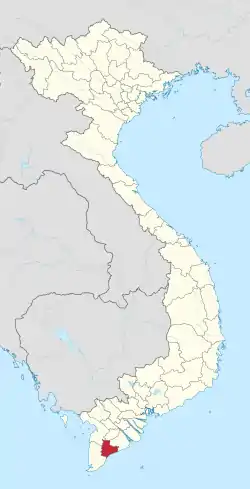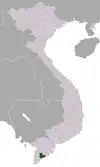Bạc Liêu province
Bạc Liêu province (Vietnamese: [ʔɓaːk̚˧˨ʔ liəw˧˧] ⓘ) is a province of Vietnam. It is a coastal province, and is situated in the Mekong Delta region of the southern part of the country.
Bạc Liêu province
Tỉnh Bạc Liêu | |
|---|---|
 Bạc Liêu windpower farm | |
 Seal | |
 Location of Bạc Liêu within Vietnam | |
| Coordinates: 9°15′N 105°45′E | |
| Country | |
| Region | Mekong Delta |
| Capital | Bạc Liêu |
| Government | |
| • People's Council Chair | Phạm Văn Thiều |
| • People's Committee Chair | Lê Thị Ái Nam |
| Area | |
| • Total | 2,669 km2 (1,031 sq mi) |
| Population (2021)[1] | |
| • Total | 1,062,959 |
| • Density | 400/km2 (1,000/sq mi) |
| Demographics | |
| • Ethnicities | Vietnamese, Khmer, Hoa |
| Time zone | UTC+7 (ICT) |
| Area codes | 291 |
| ISO 3166 code | VN-55 |
| Website | www |
Administrative divisions
Bạc Liêu is subdivided into seven district-level sub-divisions:
- 5 districts:
- 1 district-level town:
- 1 provincial city:
- Bạc Liêu (capital)
They are further subdivided into seven commune-level towns (or townlets), 50 communes, and seven wards.
Geography
Bạc Liêu is located on Mekong Delta, although it is actually located slightly to the south of the Mekong's main outflows. Bạc Liêu is around 100 kilometres (62 mi) south of Cần Thơ, the largest city in the Mekong Delta.
Economy
The most important parts of Bạc Liêu's economy are rice farming, fishing, food processing, and clothing manufacturing.
History
After the Fall of Saigon, 30 April 1975, Bạc Liêu province and Cà Mau province were merged into one new entity called Minh Hải province. In 1996, Minh Hải province was split into two, with the northeast becoming Bạc Liêu province and the southwest becoming Cà Mau province. Bac Lieu is renowned for its community of Teochew Chinese.
Culture
Vọng cổ, an important song in the traditional music of southern Vietnam, was composed in Bạc Liêu around 1918 or 1919.
Referring to Bac Lieu, many people immediately think of the homeland of Prince Bac Lieu (Công Tử Bạc Liêu) Trần Trinh Huy also called Ba Huy, or the Black Prince – was a famous player not only in Bac Lieu but even in Saigon and the South of Vietnam during the 1930s and 1940s.
References
- Statistical Handbook of Vietnam 2014 Archived 2015-07-06 at the Wayback Machine, General Statistics Office Of Vietnam
